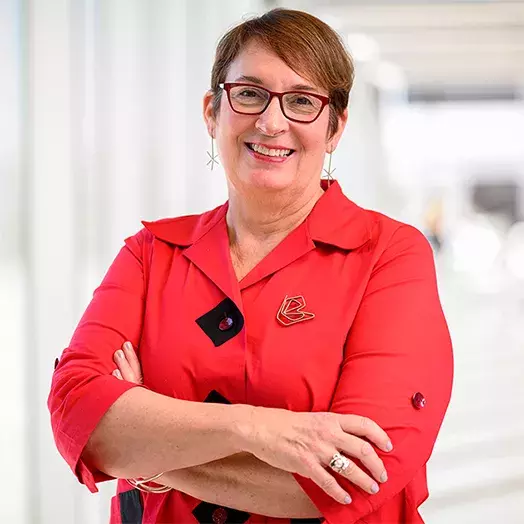Paper addresses the ways in which COVID-19 has “severely weakened the surgical innovation pipeline and ecosystem.”

Pandemic has slowed medical innovations, Toby Gordon study states
Article Highlights
- Lockdown has hindered communication among medical professionals.
- Negative impact from cancelled elective surgeries.
- Situation nonetheless has led industry to find other innovations.
The COVID-19 pandemic has worked havoc on many aspects of society, health care hardly the least among them.
In a new study for the journal Surgical Innovation, Associate Professor Toby Gordon of the Johns Hopkins Carey Business School addresses the ways in which the pandemic, as she writes, has “severely weakened the surgical innovation pipeline and ecosystem.”
Gordon, a member of the Carey faculty since 2010, also has had a four-decade association with the medical institutions of Johns Hopkins University as both an administrator and an instructor. In the following Q&A, she discusses some of the findings in her new paper, applying the expertise she has developed over a long career at the heart of the health care industry.
QUESTION: Your central point is that the pandemic “severely weakened the surgical innovation pipeline and ecosystem.” Can you generally explain how and why this weakening occurred?
TOBY GORDON: The shutdown due to the pandemic had a huge effect. Before research can happen, ideas have to happen. During COVID, stay-at-home orders and the shutdown of elective medical and surgical care and research laboratories eliminated most opportunities for the informal interactions that are part of the innovation process. For innovations from research, laboratories have to be up and running, and successful bench-to-bedside translation requires participation of patients in clinical studies. COVID created a pause. This prolonged the length of time for creation, adoption, and diffusion of new products and services into the market.
When you mention the loss of opportunities for informal interactions, what kinds of communications are you referring to, and how has the pandemic prevented them from happening?
Informal communications are those conversations that take place among colleagues, in the hallways, during meetings, or, most typically, at the coffee bar. Caffeine is thought to be the jet fuel for idea exchange. Lack of face-to-face meetings and social distancing doused these casual conversations.
You cite a lack of trust in science among some members of the public. How has this lack of trust affected medical innovation during the past year, and what do you expect its impact to be in the months and years ahead?
We saw a lack of trust around vaccines before COVID, and it has only gotten worse with COVID vaccines, along with a lack of trust in public health measures such as masking. I attribute this to Trumpism, and social media coverage has amplified the anti-science message. There is also a historic lack of trust about science from the epically racist Tuskegee syphilis study in the 1930s, and the Henrietta Lacks experience. When people are afraid to avail themselves of new and life-saving drugs, devices, or policies because they don’t believe the science, they miss out, and in business terms, the market is smaller. Market-size potential drives investor interest in new technologies and such investments are critical to cover market costs.
What can be done to overcome this lack of trust?
Many people are working on vaccine hesitancy issues, and we can learn and apply those lessons to other areas. Health care and medicine in the United States have a long way to go – beginning with community engagement at the start of the research process until the end, a more diverse and inclusive approach to clinical research participation, and dissemination in a culturally competent way. This means working through trusted community organizations, engaging community leaders to help share the message with appropriate messaging.
You note that the shift to a more managed form of health care in recent decades led to a lack of hospital beds when they were sorely needed during the early stages of the pandemic. (In fact, as a recent Yale study showed, the lack of ICU beds was tied to thousands of excess deaths from COVID-19.) How should hospital administrators respond in the wake of such tragic yet unusual circumstances? Is it reasonable to expect hospitals to maintain reserve bed space for a possible recurrence of pandemic conditions?
I don’t believe hospital administrators can solve this problem. What was seen as excess costs has been squeezed out to reduce health care expenditures in the U.S. Excess capacity, also known as surge capacity, is a cost. You have to build and equip and staff beds you may not routinely need. Staffing is a challenge in ICUs; it requires highly trained nurses, respiratory therapists, intensivists.
Some possible approaches would include coordination across hospitals, a pooling of excess capacity, but then patients would have to be moved around, which has many challenges. We saw the field-hospital surge approach as well. I think the place to start is to look at the national plan from the Obama administration and go from there.
What to Read Next

research
Health Care Consolidation Poses Hazards to Health System Goals, Polsky Cautions in NEJM ArticleWe’ve heard a lot during the past year about cancelled elective surgeries. How have these cancellations affected the innovation pipeline?
It’s a parable like the children’s book, If You Give a Mouse a Cookie. If you cancel elective surgery, the hospital loses revenue. If the hospital loses revenue from its highest margin business – elective surgery – it loses money for capital investments and new programs. If it loses money for capital investments and new programs, it doesn’t buy new products. If it doesn’t buy new products, then the companies that sell new products lose revenue. Without revenue, investors won’t invest. The pipeline gets more competitive, and fewer innovations will get funded.
Despite the setbacks to medical innovation, can you cite any unexpected discoveries and advances that resulted from the scientific community’s response to the pandemic?
There are several good examples:
- We saw companies cross over into health care to make ventilators and PPE; Under Armour, for instance, started making face masks.
- Technologies and people were adapted to new uses: Three-D printing was used for some PPE creation. Operating rooms were used as ICUs. And specialized nurses and doctors were redeployed in new roles.
- New methods of care emerged: A new approach to help lung function was developed, called proning [turning patients onto their stomachs], to better position patients in the ICUs. Drive-through medicine led to mass vaccination sites and drive-through diagnostics and treatment. Some surgeries were moved out of hospitals to alternative settings. At the same time, there were fewer routine screenings; the results of which are still to be determined.
- Telemedicine and digital health care took off.
- And we saw the development of new drugs, diagnostics, immunotherapies, and vaccines.


